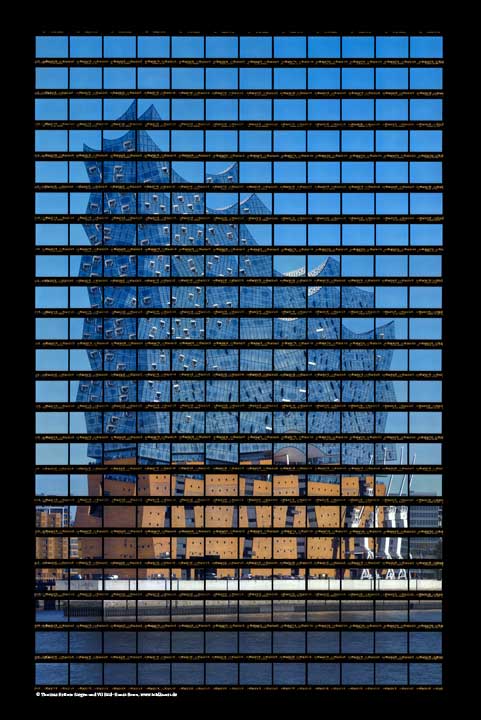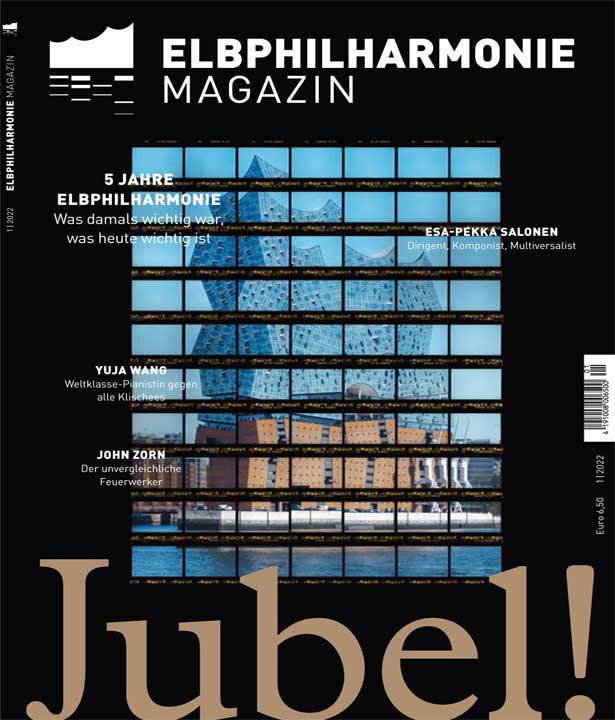A new view of the Elbphilharmonie in Hamburg
In sunny, golden October 2021, under a brilliant blue sky, Thomas Kellner set out to depict the Elbphilharmonie Hamburg in a new light of fine art photography. The artist examined not only the external impact of the neo-Gothic landmark, but also that of the interior. He redefined the image of the Elbphilharmonie with his visual language into an intensive view of Elphi. With this series, Kellner created a new distorted view of the landmark in a deconstructive, yet reconstructed playful way of the object, as we do not yet know it from the Elbphilharmonie in Hamburg.
"Just as the dimensions of a small pictorial motif in Kellner's work ultimately determine those of the large picture, so in Cage's work the overall construction is decided in the small structural points." Kneppe, Julia. 2014. "Interface Rhythm, Chance, Deconstruction? " In Thomas Kellner: Kontakt, edited by Thomas Kellner, 31-35, 36-40 engl. Lüdenscheid, Berlin: Seltmann+Söhne.

Elbphilharmonie in Hamburg belongs to the portfolio of Tango Metropolis
The construction of a new landmark for Hamburg: Elbphilharmonie
The concert hall, completed in 2017, is one of Hamburg's most expensive landmarks. The completion of the building was scheduled for 2010 after many years of preparation, but was delayed several times due to a one-and-a-half-year construction stop. It was only after the election of the mayor, now chancellor, Olaf Scholz and a project reorganization between architects and builders in 2013 that the new landmark continued to be built and was completed in 2017. The projected sum for the completion of the building was 77 million euros, which was missed by a factor of 11.24, resulting in a sum of around 866 million euros. One of the architects, Pierre de Meuron, began seriously considering abandoning the project when he was accused of driving up construction costs with repeated extra requests and failure to deliver the building plans. He said he had never experienced a project anywhere in the world where the parties involved made life so difficult for themselves. For the project, which cost around 866 million, Jacques Herzog and Pierre de Meuron received a fee of 94 million euros, but according to them, they did not make a profit. Herzog & de Meuron's design is now considered unsurpassed.
"It playfully captures the rhythm of the man-made world, full of erected church buildings and factories, serving the viewer not the monuments in detail but the rhythm of the whole landscape." Chmyreva, Irina. 2013. “Genius Loci.” In Thomas Kellner: Genius Loci – Zwei Siegener Im Zarenland, edited by Oliver Seltmann, 9–14. Lüdenscheid, Berlin: Seltmann+Söhne.
Elbphilharmonie, a building in a class of its own
The glass base, reminiscent of a sail in the wind, was built on top of Kaispeicher A, which was erected in 1963. The curvature of the windows is reminiscent of an inflated sail in a storm. The glass sail, which has been fitted with reflective glass, reflects the water and weather of the Elbe and thus provides a continuous comparison with the voyage of the ship. Attention to detail can be found on the floor of the plaza. Here, a brickyard was specially hired to produce aesthetically flawed bricks. These represent the bricks of the great archetype of Kaiserspeicher A. The reddish-brown bricks are reminiscent of wood, the prow of a sailing ship, the white wedge walls make the water around them collapse, like the spray on the high seas. A sequence of details that make the Elbphilharmonie Hamburg look like a sailing ship at sea.
During the 80-metre-long and 21-metre-high escalator ride to the plaza, the passenger initially sees only that he or she is travelling towards a light over the largest section of the two-and-a-half-minute ride. The steps of the 21-metre escalator, also called the Tube, are not driven from above as usual, but by four decentralized drives that are electronically synchronized. The inclination of the steps drops from 23 degrees at the beginning to about 11 degrees at the end of the staircase. Everything about this building has been extravagant and designed to a new scale. Due to its height of 110 meters and the lowest point, which is 30 meters lower on the east façade, it is one of the tallest inhabited buildings in Hamburg. Those who want to experience a night in the glass and brick-lined building can do so at a height of 37 metros. The 80-metre and 21-metre-high escalator takes you to the outer deck of the plaza, from where you can experience the panorama of the North Elbe. Before the official opening of the Plaza on 5 November, up to 16,000 guests were counted daily. It welcomed its millionth visitor just 4 months after opening. This happened at the end of February, and at the beginning of June the mark of 10 million visitors was cracked.
The hotel chain Westin Hotels & Resorts operates the 4-star hotel in the eastern part, which is spread over the 6th-20th floors. It opened on 4 November 2016, with a spa area on the 6th floor and a restaurant and conference area on the 7th floor. The lobby is on the 8th floor, with access from the plaza and with lifts from the ground floor entrance area. The idea of using the hotel as a place for everyone has unfortunately failed, the cheapest room costs 220 euros, the most expensive around 3,000 euros.
"Music and architecture, the architecture is like a final point that completes the artistic process and at the same time it is also the starting point for a new artistic journey of the viewer - that's Kellner." Chmyreva, Irina. 2013. “Genius Loci.” In Thomas Kellner: Genius Loci – Zwei Siegener Im Zarenland, edited by Oliver Seltmann, 9–14. Lüdenscheid, Berlin: Seltmann+Söhne.
The perfection of the sound of Hamburg's Elbphilharmonie.
The Elphi is not only an interesting building in terms of its architecture, not to forget the concert halls. The world-famous acoustician Yasuhisa Toyota was hired to create the best possible sound. Distributed over the entire wall surface are about a million fist-sized honeycombs that individually dissipate sound. In addition, the acoustics of the large hall are improved because it is supported by 362 spring packs with 20 steel springs each. The small hall has individually curved wall panels from the Loire Valley, which were specially milled. These were designed like honeycombs to ensure optimal acoustics. The small hall is mainly used for the performance of chamber music. It is also open to other uses, such as jazz concerts or banquets. The small hall has a capacity of 550 listeners, considerably less than the large hall, which, with seats for up to 2,100, enchants listeners with a unique musical experience. Unlike other concert halls, the organ here is accessible in the middle of the audience. Therefore, the front pipes had to be protected with a special coating. The instrument has 69 stops, of which 380 of the 4,765 pipes are made of wood. Of the 84 ranks of pipes, the first 7 stops (8' and 4') in the chancel work with up to 73 pipes. As a result, it has 12 more notes than there are keys on the keyboards. Therefore, it is extended for the super-octave couplers up to c5.
The hall has been the subject of controversy since its inception. Many musicians and conductors argue whether the sound of the Elbphilharmonie is an acoustic miracle or a faulty construction. A Munich orchestra caused outrage among the audience when star tenor Jonas Kaufmann could not be heard and the audience could hardly contain itself with annoyance. Kaufmann said it was due to the hall and the custom-cast plaster alloy. The chief conductor of the Residence Orchestra complained that a proper woodwind sound could not be achieved in the Elbphilharmonie in Hamburg. A seemingly endless debate. But it's not because of the hall, it's because of the placement of the artist and the insufficient rehearsal time, because here the concerts are too closely timed.
"From the interaction between the compositional process, the facture and the perception of the viewer, to whom the indissoluble connection of the images is revealed by the contact print, a temporal dimension emerges, such as one finds primarily in musical compositions." Kneppe, Julia. 2014. "Interface Rhythm, Chance, Deconstruction?" In Thomas Kellner: Kontakt, edited by Thomas Kellner, 31-35, 36-40 Engl. Lüdenscheid, Berlin: Seltmann+Söhne.
Jacques Herzog and Pierre de Meuron and the construction of Elbphilharmonieas an iconic building for Hamburg
Star architects Jacques Herzog and Pierre de Meuron designed the first rudiments of the spectacular building back in 2007. There was already another design in 2000 by Berlin architects Doris Gruber and Bernhard Popp, but this is unknown to many. In 2001, Jacques Herzog and Pierre de Meuron were awarded the prestigious Pritzker Prize, comparable to a Nobel Prize for architects. Even before that, they were no strangers to the architectural world; with projects such as the Allianz Arena in Munich and the much-noticed conversion of a power station into the Tate Gallery of Modern Art in London, the architect duo achieved an international breakthrough.
"Kellner's pictures tremble, they sway, they dance." Kneppe, Julia. 2014. "Interface Rhythm, Chance, Deconstruction?" In Thomas Kellner: Kontakt, edited by Thomas Kellner, 31-35, 36-40 engl. Lüdenscheid, Berlin: Seltmann+Söhne.
The new series about the Elbphilharmonie in Hamburg
The artist applies his principle of the sweeping arc of contact sheet here. The Elbphilharmonie is pushed into an unfamiliar deconstructive perspective reminiscent of a moving sea. Hamburg's Elbphilharmonie forms the continuation of his work with iconic buildings. The dancing, swaying fragments enhance the beauty, the interior becomes visible with its dancing accumulation and details that were eclipsed by the façade are revealed. The foyer, resembling an origami, is once again photographically folded rhythmically by Kellner. The deconstruction of the large hall oscillates in cubic rhythms. The small hall is reconstructed in such a way that the spotlights in the sweeping contrast of the jet-black ceiling make a starry sky appear in the firmament. The view of the dark ceiling is made even more impressive by the luminous warm atmosphere of the hall. The hybrid of deconstructive elements and depth makes it appear like a horizon in the twilight.
In this series, the fine art photographer works with light influences and thus brings parts into the foreground. The result is an almost effect like an aura of the picture and the Elbphilharmonie.His approach leaves the corridors of the foyer completely dissolved. Here one loses the complete reference to the real object and arrives at a disoriented, even Dadaistic perspective of the pictorial language. The façades of the Elbphilharmonie Hamburg shake and break like a storm at sea. The dynamic artist makes the Elfi dance like a buoy on the Elbe in Hamburg. His works are somewhere between deconstructivism, cubism and montage. The German fine art photographer Kellner was born in Bonn in 1966.









